Micro-hydro power systems can provide sustainable, renewable energy for your home by harnessing the power of flowing water on your property. These systems typically generate 5-100 kilowatts of electricity, offering a clean alternative to fossil fuels. You'll need a reliable water source with sufficient flow and head (vertical drop) to make it work. Benefits include 24/7 energy availability, low operational costs, and a reduced carbon footprint. To get started, assess your property's hydro potential by measuring water flow and head. With proper installation and maintenance, you can achieve energy independence and long-term cost savings. There's much more to explore about this eco-friendly power solution.
Understanding Micro-Hydro Power Systems
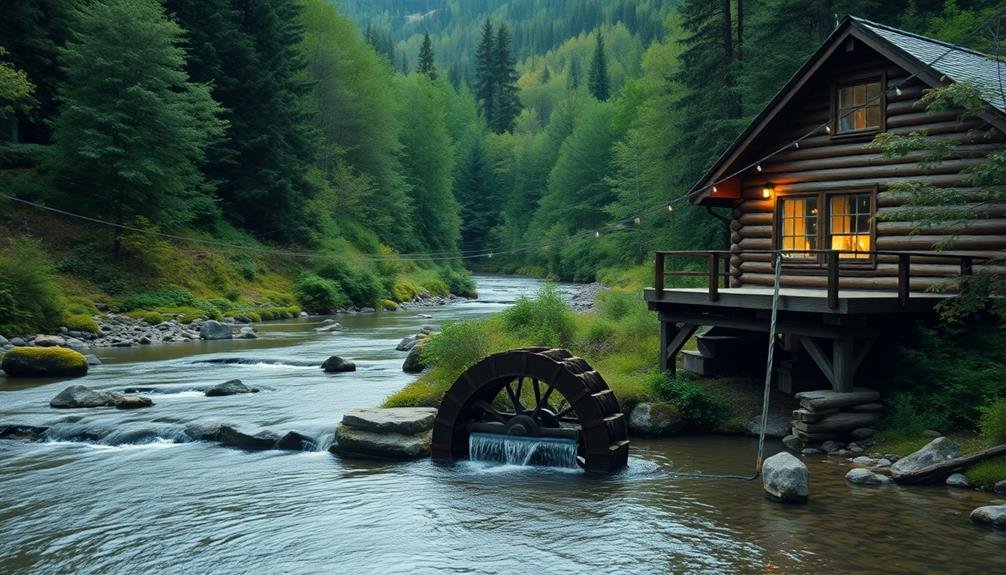
Micro-hydro power systems harness the energy of flowing water to generate electricity for your home. These systems work by diverting a portion of a stream or river through a turbine, which spins to produce electricity. Unlike large-scale hydroelectric dams, micro-hydro systems are small, typically generating 5 to 100 kilowatts of power.
You'll need a reliable water source with sufficient flow and head (vertical drop) to make a micro-hydro system viable. The amount of power generated depends on these factors, as well as the efficiency of your turbine. Common types include Pelton, Turgo, and crossflow turbines, each suited for different water conditions.
A typical system consists of an intake, penstock (pipeline), turbine, generator, and tailrace. The intake diverts water, the penstock channels it to the turbine, and the tailrace returns water to the stream.
You'll also need a controller to regulate voltage and frequency, and batteries for energy storage.
Micro-hydro systems can provide continuous, reliable power with minimal environmental impact. They're often more cost-effective than solar or wind for off-grid homes near suitable water sources.
However, they require careful planning and may be subject to local regulations.
Benefits of Home Micro-Hydro Energy
Harnessing the power of flowing water through micro-hydro energy offers numerous benefits for homeowners.
You'll enjoy a renewable, clean energy source that's available 24/7, unlike solar or wind power. This constant supply guarantees a reliable electricity source for your home, reducing your dependence on the grid.
Micro-hydro systems are cost-effective in the long run. After the initial installation, you'll have minimal operational costs and low maintenance requirements.
These systems can last for decades, providing a steady return on your investment. You'll also see a significant reduction in your electricity bills, potentially even eliminating them entirely.
Environmental benefits are substantial. You're reducing your carbon footprint by using a clean energy source that doesn't produce greenhouse gases or other pollutants.
Micro-hydro systems have a minimal impact on local ecosystems when properly designed and installed.
Additionally, you'll gain energy independence and resilience. During power outages, your micro-hydro system can continue to provide electricity, guaranteeing your home remains powered.
This self-sufficiency can be particularly valuable in remote areas or during natural disasters.
Assessing Your Property's Hydro Potential
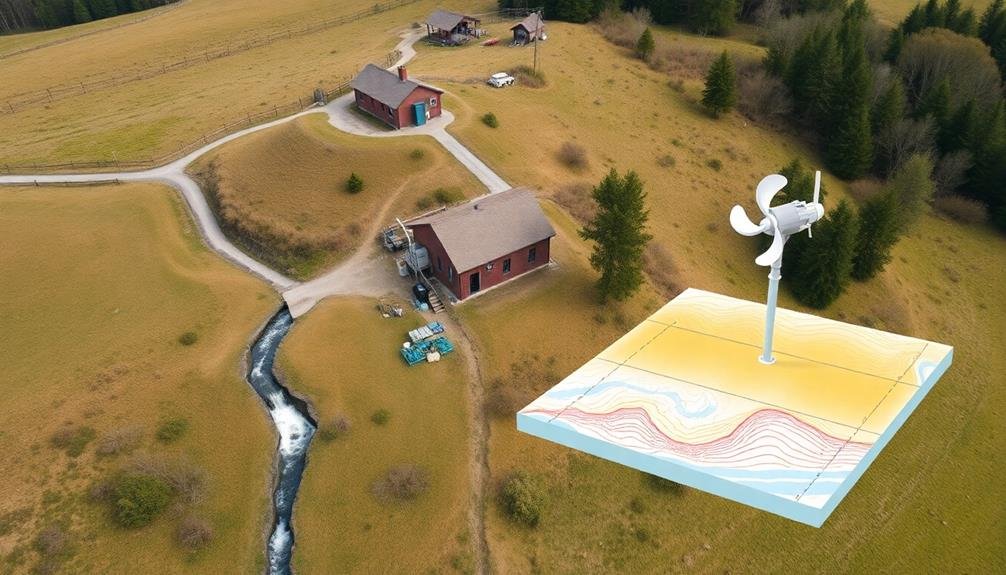
Before diving into a micro-hydro project, you'll need to analyze your property's potential for generating hydroelectric power. Start by evaluating your water source's flow rate and head (vertical drop). Measure the flow rate by timing how long it takes to fill a container of known volume. Calculate the head by determining the elevation difference between your water source and the turbine location.
Next, consider the seasonal variations in water flow. Your system should be designed for the lowest flow periods to guarantee year-round power generation.
Analyze the distance from your water source to your home, as longer distances may require additional piping and increase costs.
Examine your property's topography and any legal restrictions on water usage. You'll need to obtain necessary permits and water rights before proceeding.
Consider environmental impacts, such as effects on local ecosystems and fish populations.
Components of a Micro-Hydro Setup
To set up your micro-hydro system, you'll need to understand its key components.
The intake and diversion structures capture and channel water flow, while the turbine and generator convert the water's energy into electricity.
You'll also require control and distribution equipment to manage the power output and deliver it to your home.
Intake and Diversion
The intake and diversion system forms the heart of your micro-hydro setup, channeling water from the stream to your turbine.
It's vital to design this component carefully to maximize efficiency and minimize environmental impact. You'll need to create a small dam or weir to divert water into your intake pipe, ensuring it's sturdy enough to withstand high water flows and debris.
Your intake should include a trash rack to filter out leaves, sticks, and other debris that could damage your turbine.
It's important to maintain this regularly to prevent clogging. The pipe leading from the intake to your turbine should be sized correctly to minimize friction losses and maintain water pressure.
When designing your intake and diversion system, consider these key factors:
- Water rights and local regulations
- Seasonal water flow variations
- Fish passage requirements
- Sediment management
Turbine and Generator
Selecting the right turbine and generator is vital for maximizing your micro-hydro system's efficiency. The turbine converts the water's kinetic energy into mechanical energy, while the generator transforms this mechanical energy into electricity.
You'll need to choose between impulse and reaction turbines. Impulse turbines, like Pelton wheels, work best with high head and low flow rates. They're ideal for steep terrain.
Reaction turbines, such as Francis or Kaplan types, suit low head and high flow situations, perfect for flatter landscapes.
Your generator's capacity should match your turbine's output. Most micro-hydro setups use either induction or permanent magnet generators. Induction generators are cost-effective and robust but require a connection to the grid.
Permanent magnet generators are more efficient and can operate off-grid, but they're pricier.
Consider factors like water flow, head height, and your power needs when selecting your turbine-generator combo. It's important to size your system correctly to avoid underperformance or wasted energy.
Don't hesitate to consult with a micro-hydro expert to guarantee you're making the best choice for your specific site conditions.
Control and Distribution
Once you've chosen the right turbine and generator, you'll need to focus on controlling and distributing the power they produce. The control system regulates the voltage and frequency of the electricity generated, guaranteeing it's compatible with your home's electrical needs.
You'll need an inverter to convert the DC power from the generator into AC power for household use. A charge controller is essential to prevent overcharging of batteries if you're using a battery bank for energy storage. It also helps protect your system from damage due to voltage fluctuations.
The distribution system includes wiring, circuit breakers, and safety switches to deliver electricity safely throughout your home.
Key components of control and distribution systems include:
- Inverter
- Charge controller
- Battery bank (optional)
- Load dump controller
Don't forget to install proper grounding and lightning protection to safeguard your micro-hydro system and home.
You'll also need to connect your system to the main electrical panel, guaranteeing it meets local electrical codes and regulations. Consider hiring a licensed electrician for this part of the installation to ensure safety and compliance.
Installation Process and Considerations
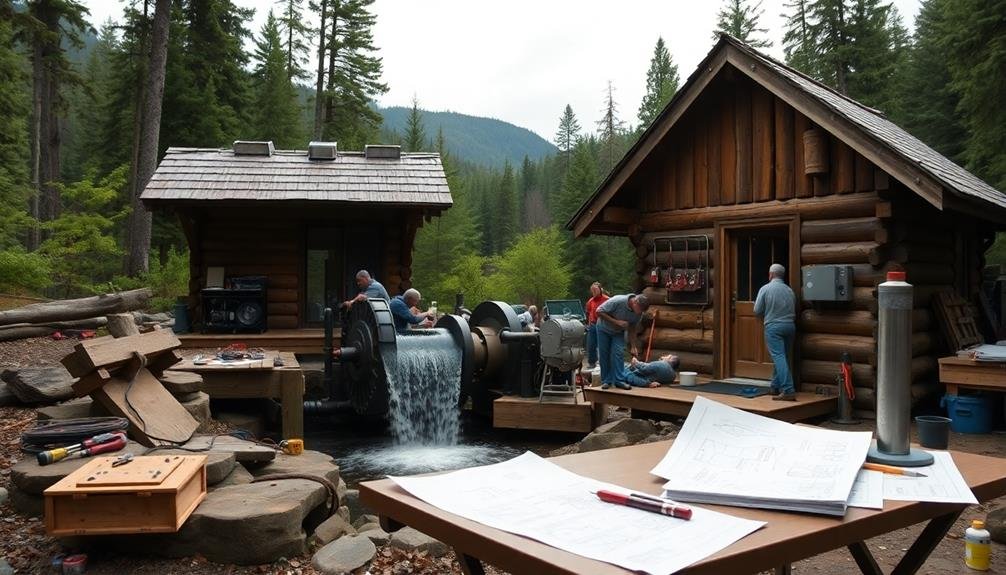
Installing a micro-hydro power system requires careful planning and expert guidance. You'll need to assess your site's potential, obtain necessary permits, and design a system that meets your energy needs. Start by conducting a thorough site survey to determine water flow, head, and potential power output.
Next, choose appropriate equipment based on your site's characteristics and energy requirements. You'll need to select a turbine, generator, and control system that work together efficiently. Consider factors like seasonal variations in water flow and environmental impact when making your decisions.
Here's a quick overview of the installation process:
| Step | Action | Considerations |
|---|---|---|
| 1 | Site preparation | Access, erosion control |
| 2 | Intake construction | Debris protection, fish safety |
| 3 | Penstock installation | Pipe material, burial depth |
During installation, you'll need to construct the intake structure, lay the penstock, and set up the powerhouse. Confirm proper connections between components and implement safety measures. Don't forget to install a tailrace to return water to the stream.
After installation, you'll need to test and commission the system. Regular maintenance will be essential to keep your micro-hydro system running smoothly and efficiently for years to come.
Maintenance and Troubleshooting
Proper maintenance and troubleshooting are essential to keeping your micro-hydro system running efficiently. Regular inspections and cleaning of the intake screen, penstock, and turbine will prevent debris buildup and guarantee peak performance.
You'll need to check for leaks, wear, and tear on components, especially bearings and seals. It's vital to monitor your system's output and compare it to expected levels to catch any issues early.
When troubleshooting, start by checking the most common problems:
- Low water flow due to drought or blockages
- Electrical issues in the generator or wiring
- Mechanical problems with the turbine or drive system
- Control system malfunctions
If you're not comfortable diagnosing issues yourself, don't hesitate to call a professional. They can perform more complex maintenance tasks and repairs.
Keep a log of your system's performance and any maintenance performed. This record will help you spot trends and predict when components might need replacement.
Cost Analysis and ROI
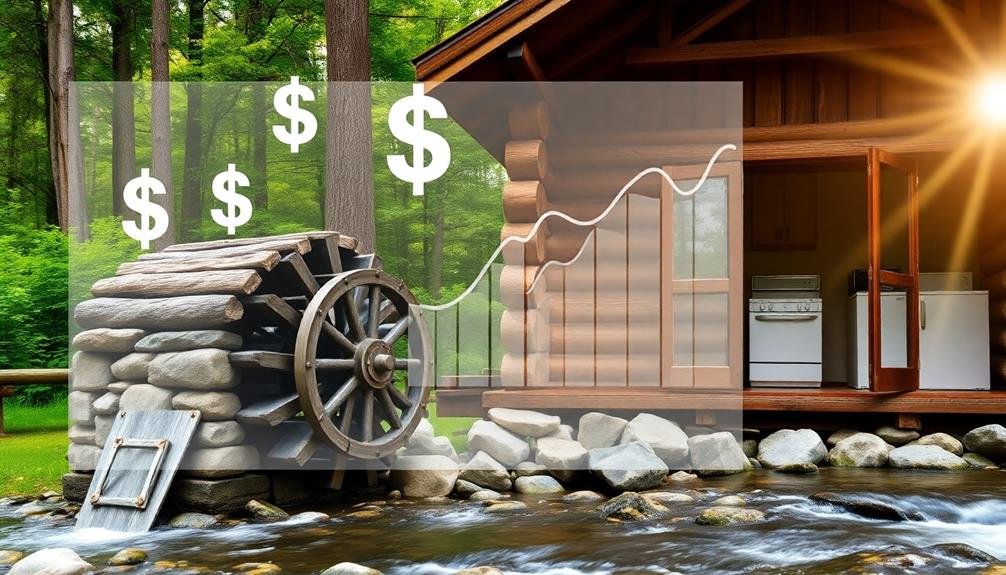
A thorough cost analysis is essential when considering a micro-hydro power system for your home. You'll need to account for initial installation costs, ongoing maintenance expenses, and potential energy savings over time. The upfront investment typically ranges from $5,000 to $50,000, depending on your property's characteristics and power requirements.
To calculate your return on investment (ROI), estimate your annual energy savings by multiplying your system's expected power output by your current electricity rate. Factor in maintenance costs, which usually amount to 1-2% of the initial investment annually.
Don't forget to research available tax incentives or rebates, as these can greatly reduce your overall costs.
The payback period for a micro-hydro system varies but often falls between 5 to 10 years. After this point, you'll enjoy free, renewable energy for decades.
Consider the long-term benefits: increased property value, energy independence, and reduced carbon footprint. While the initial investment may seem substantial, many homeowners find that the long-term savings and environmental benefits make micro-hydro power a worthwhile investment for their sustainable future.
Environmental Impact and Regulations
When considering micro-hydro power for your home, you'll find it has a minimal ecological footprint compared to other energy sources.
You'll need to navigate permitting and legal requirements, which vary by location and can involve local, state, and federal regulations.
Don't forget to account for fish and wildlife considerations, as these systems can impact aquatic ecosystems and may require specific measures to protect local species.
Minimal Ecological Footprint
Environmental consciousness is at the heart of micro-hydro power systems. When you install a micro-hydro system on your property, you're choosing a renewable energy source with minimal ecological impact. Unlike large-scale hydroelectric dams, micro-hydro doesn't greatly alter river ecosystems or disrupt fish migration patterns. You'll be harnessing the power of flowing water without causing major environmental disruptions.
Micro-hydro systems have several eco-friendly advantages:
- They don't produce greenhouse gas emissions during operation
- They've a small physical footprint, preserving natural landscapes
- They don't require fuel transportation or storage
- They can often be integrated into existing water systems
You'll find that micro-hydro systems work in harmony with the natural water cycle. They don't consume water; instead, they simply borrow its kinetic energy before returning it to the stream. This means you're not depleting water resources or altering the local hydrology.
Additionally, modern micro-hydro turbines are designed to minimize impacts on aquatic life, allowing fish and other organisms to pass through safely. By choosing micro-hydro power, you're embracing a clean energy solution that respects and preserves the environment around you.
Permitting and Legal Requirements
While micro-hydro systems offer notable environmental benefits, you'll need to navigate a complex landscape of permits and regulations before installation.
First, contact your local water resource department to determine if you have water rights for power generation. You'll likely need to secure permits from multiple agencies, including state environmental departments and the Federal Energy Regulatory Commission (FERC).
Environmental impact assessments are often required to guarantee your system won't harm local ecosystems or wildlife. You'll need to demonstrate that your project won't considerably alter water flow, temperature, or quality.
Fish passage and protection measures may be necessary if your stream supports aquatic life.
Zoning laws and building codes can affect your installation, so check with your local planning department. Some areas have specific regulations for renewable energy systems. You may need to obtain electrical permits and have your system inspected for safety compliance.
It's essential to research and comply with all relevant laws to avoid legal issues and potential fines.
Consider consulting with a lawyer experienced in renewable energy projects to help you navigate the permitting process efficiently.
Fish and Wildlife Considerations
How does your micro-hydro project affect local aquatic ecosystems?
It's essential to evaluate the impact on fish and wildlife when installing a micro-hydro system. You'll need to assess how your project might alter water flow, temperature, and habitat for aquatic species. Many jurisdictions require environmental impact studies and mitigation measures to protect local ecosystems.
To minimize harm to fish and wildlife, evaluate these key factors:
- Fish passage: Confirm your system doesn't block fish migration routes
- Water quality: Maintain appropriate water temperature and oxygen levels
- Sediment management: Prevent excessive erosion or sediment buildup
- Habitat preservation: Protect riparian zones and aquatic vegetation
You'll likely need to work with local wildlife agencies to develop a plan that balances energy production with ecosystem protection.
This may involve installing fish screens, creating fish ladders, or implementing seasonal operational restrictions.
Remember, your goal is to generate clean energy while minimizing ecological disruption.
Integrating With Existing Power Systems
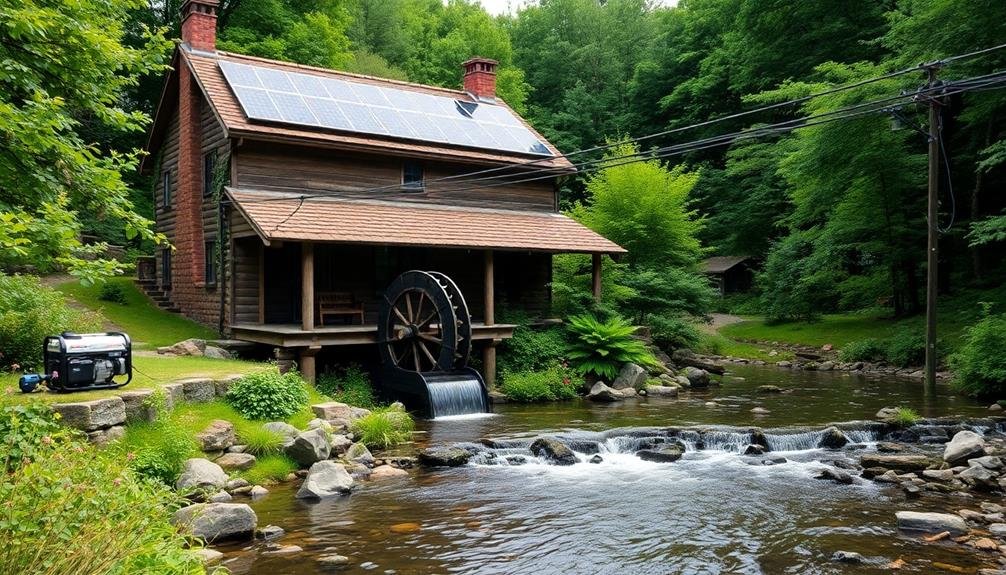
When it comes to integrating micro-hydro power with your existing electrical system, you'll need to take into account a few key factors. First, determine whether you want to operate off-grid or grid-tied. Off-grid systems require battery storage and a backup generator, while grid-tied systems allow you to sell excess power back to the utility company.
You'll need to install an inverter to convert the DC power generated by your micro-hydro system into AC power compatible with your home's electrical system. Choose an inverter that matches your system's voltage and power output. For grid-tied systems, you'll also need a grid-tie inverter that synchronizes with the utility grid.
Verify your electrical panel can handle the additional power input. You may need to upgrade your panel or install a subpanel dedicated to your micro-hydro system.
Don't forget to include proper safety devices like circuit breakers and disconnect switches.
Consult with a licensed electrician experienced in renewable energy systems to help design and install the integration. They'll verify your system meets local codes and utility requirements, maximizing efficiency and safety while minimizing potential issues with your existing power setup.
Case Studies: Successful Home Implementations
Now that we've covered the technical aspects of integrating micro-hydro power, let's look at real-world examples of successful home implementations.
You'll find inspiration in these case studies, showcasing how homeowners have harnessed the power of water to generate clean electricity.
In rural Oregon, the Johnson family installed a 5kW system on their property's creek, providing 80% of their annual energy needs. They've reduced their carbon footprint and saved thousands on utility bills.
In Scotland, the MacLeod's 10kW setup powers their entire farm, including electric fencing for livestock. They've achieved energy independence and sell excess power back to the grid.
Consider these key takeaways from successful implementations:
- Proper site assessment is essential for ideal system design
- Involving local authorities early streamlines the permitting process
- Regular maintenance guarantees long-term efficiency and reliability
- Community engagement can lead to shared resources and knowledge
You'll notice that successful micro-hydro adopters often become advocates for sustainable energy in their communities.
They're living proof that with careful planning and execution, you can turn your property's water resources into a valuable, eco-friendly power source.
As you explore your own micro-hydro potential, remember that these case studies offer valuable insights and lessons learned.
Future of Residential Micro-Hydro Power
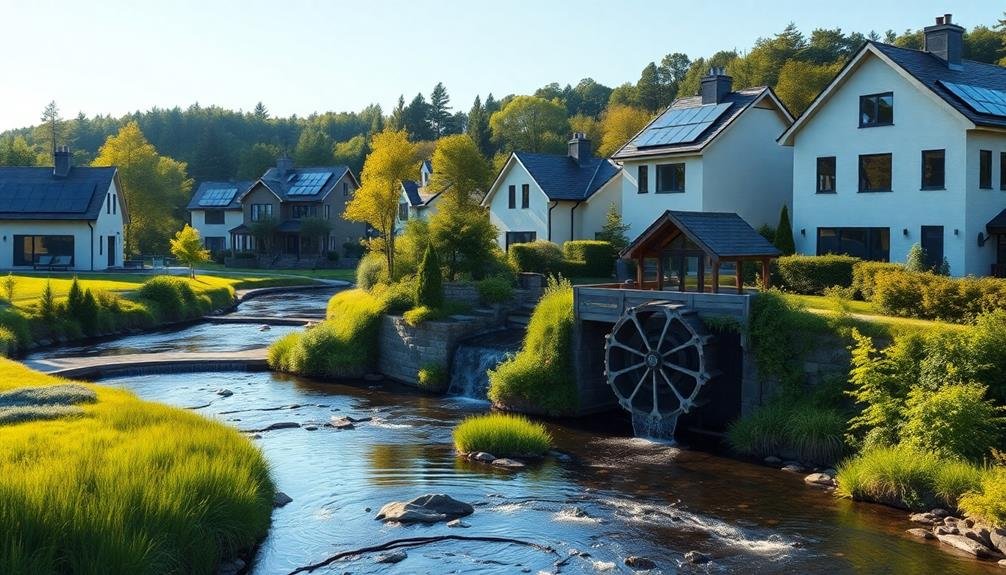
The future of residential micro-hydro power is looking brighter than ever. As technology advances and costs decrease, you'll see more homeowners adopting this sustainable energy solution. Improved turbine designs will increase efficiency, allowing you to generate more power from smaller water sources.
You'll also benefit from smart grid integration, enabling you to sell excess electricity back to the grid and optimize your energy usage. In the coming years, expect to see more plug-and-play micro-hydro systems that are easier to install and maintain.
These user-friendly setups will make it simpler for you to harness the power of water on your property. You'll also find increased government incentives and support for micro-hydro installations, making it more affordable to invest in this clean energy source.
As climate change concerns grow, micro-hydro power will play a vital role in reducing carbon emissions. You'll be part of a larger movement towards decentralized, renewable energy production.
With ongoing research and development, you can look forward to even more innovative solutions that'll make micro-hydro power an increasingly attractive option for powering your home sustainably.
Frequently Asked Questions
Can Micro-Hydro Systems Work in Areas With Seasonal Water Flow?
Yes, you can use micro-hydro systems in areas with seasonal water flow. You'll need to design your system to account for fluctuations, possibly incorporating storage solutions or backup power sources for low-flow periods. It's essential to assess year-round water availability.
How Noisy Are Micro-Hydro Turbines During Operation?
You'll find micro-hydro turbines are surprisingly quiet. They're often compared to a whisper or gentle stream. You might hear a low hum or soft whoosh, but it's typically not disruptive, especially when installed properly.
What Happens to Excess Energy Produced by Micro-Hydro Systems?
You'll typically store excess energy from your micro-hydro system in batteries for later use. If you're connected to the grid, you can sell surplus electricity back to your utility company, reducing your overall energy costs.
Are There Any Risks to Local Wildlife From Micro-Hydro Installations?
Yes, there can be risks to local wildlife. You'll need to contemplate fish migration, habitat disruption, and water quality changes. However, with proper design and mitigation measures, you can greatly reduce these impacts on the ecosystem.
Can Micro-Hydro Power Be Used for Off-Grid Cabins or Remote Locations?
Yes, you can use micro-hydro power for off-grid cabins or remote locations. It's an excellent option if you've got a reliable water source nearby. You'll generate clean electricity without relying on the grid or fossil fuels.
In Summary
You've now explored the potential of micro-hydro power for your home. It's a sustainable energy option that can greatly reduce your electricity bills and carbon footprint. While it requires specific site conditions and initial investment, the long-term benefits are substantial. As technology advances and awareness grows, micro-hydro systems will likely become more accessible. Consider evaluating your property's potential – you might be surprised by the untapped energy flowing through your land.





Leave a Reply